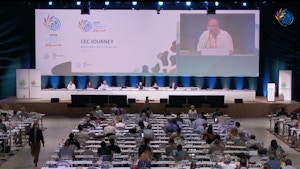The Covid-19 crisis has caused scientists, governments, and public-health experts to scramble to understand the relationship between the transmission of zoonotic diseases (those that jump from animals to humans) and environmental variability, patterns of human mobility, and commerce.
In the process, it has become painfully clear how much we have yet to learn about the world around us.
But while no one can credibly predict what comes next, we can certainly be better prepared for the next phase of global life with Covid-19.
In a sense, viewing the disease and its impact through multiple lenses – epidemiological, economic, political, and social – obstructs our vision. Without a systematic, holistic approach, leaders will continue to miss important pieces of the puzzle.
“
Covid-19 has forced us to recognise that the Anthropocene signifies a relentless feedback loop in which our behavior unleashes chain reactions that accelerate both climate change and the spread of pandemics.
Such an approach should start by rejecting the misleading divide between man and nature. The term “Anthropocene” that is now applied to our age has given us a false sense of control over the environment.
Covid-19 has forced us to recognise that the Anthropocene signifies a relentless feedback loop in which our behavior unleashes chain reactions that accelerate both climate change and the spread of pandemics.
With no infrastructural or geopolitical boundaries between us and the natural world, neither nationalism nor protectionism can stop this process.
Related to this, we no longer have the luxury of ignoring tail risks – the low-probability but high-impact events that show up on the margin of any probability distribution. In complex systems, these faint signals are more plugged in to the whole and can have multiplicative rather than linear effects.
We witnessed this in 2008, when the subprime mortgage meltdown in the United States rapidly mutated into a global financial crisis. And we are seeing the same process at work with Covid-19, which has brought global mobility to a near-standstill and cratered much of the world economy.
Neither of these were “black swan” events, for the risk was widely known. Although we failed to leverage that foresight, the precautionary principle dictates that we implement measures to mitigate such downside risks should they emerge.
What does this mean for the crucial period ahead? The arrival of summer in the Northern Hemisphere has brought a flurry of speculation that warmer and wetter weather – above the virus’s optimal range of 5-11ºC – will hold down the infection rate. But even if the hoped-for relationship between transmission and warm weather is valid, it may not be causal or straightforward.
Moreover, any assessment of the coming months must consider typical seasonal behavior. Warm weather does nudge more people outdoors, but it also means more air-conditioning while indoors, mimicking conditions favorable to the virus.
The data we must collect in the coming months will provide insight into how best to balance disease-limiting natural conditions with disease-enabling artificial conditions.
Everyone should keep three issues on their radar in the months ahead. First, the phased reopenings across North America, Europe, and Asia have been accompanied by social-distancing guidelines.
Given the population density of major cities in these regions, warm temperatures will not eradicate the virus on their own; public-health instructions must be followed. Thus far, that has not been the case in much of the US.
Second, a feature of virulent strains such as SARS-CoV-2 (the virus that causes Covid-19) is their ability to evolve rapidly. Despite favorable climatic conditions, new, more lethal strains may emerge.
Lastly, whatever happens in the next 2-3 months, winter is right around the corner. Absent an effective vaccine against the predominant strains of SARS-CoV-2, which unfortunately is at least 12-18 months away, a second and deadlier wave of infections seems certain.
Modeling the far-reaching and complicated interactions between biology, climate, and society helps us to anticipate the path the virus might take. But because so many potential scenarios lie ahead, all such models must be interpreted with caution.
That is why political leaders who would use them appropriately must trust scientific authorities, rather than muzzling them or cherry-picking their findings to suit a narrow partisan agenda. No country can afford a leader who, like US President Donald Trump and his Brazilian counterpart, Jair Bolsonaro, follows his “gut.”
We don’t yet know enough about Covid-19 to cure it or prevent it. But our accumulated knowledge of ecological systems, virology, genetics, fluid dynamics, epidemiology, anthropology, clinical medicine, microbiology, and dozens of other scientific branches offer a wealth of insights that can prevent the current pandemic from upending modern life – if only we use it.
Michael Ferrari is Managing Partner at Atlas Research Innovations and a senior fellow at the Wharton School. Parag Khanna is Founder of FutureMap and author of Connectography and The Future is Asian. Spencer Wells is Founder of the National Geographic Genographic Project and author of The Journey of Man and Deep Ancestry.
Copyright: Project Syndicate, 2020.
www.project-syndicate.org























